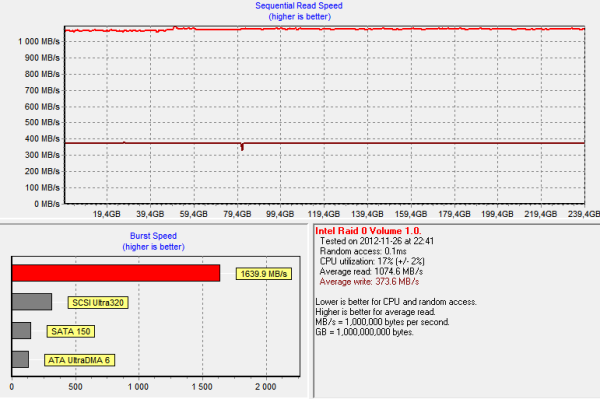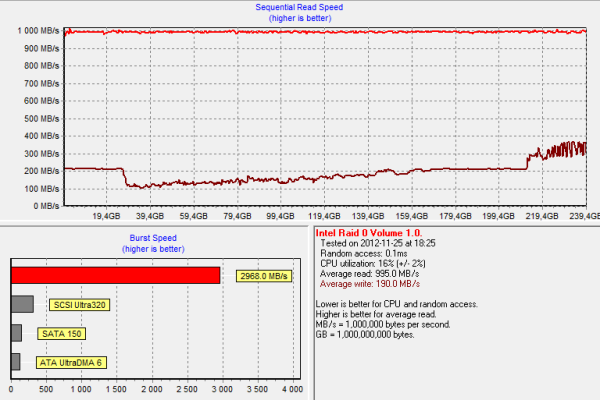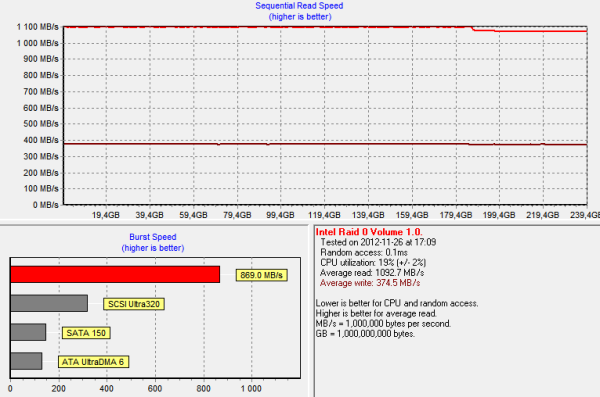TRIM & RAID-0 SSD Arrays Work With Intel 6-Series Motherboards Too
by Kristian Vättö on November 28, 2012 11:53 AM ESTA few months ago, Intel brought TRIM support to RAID-0 SSD arrays but limited it to its latest 7-series chipsets. As 7 and 6-series chipsets are very similar, there was no good explanation to why Intel didn't include support for 6-series chipsets other than forced feature differentiation and/or not wanting to go through a lengthy validation process on an older platform. We have covered the reasons why you should want TRIM in the past but the main benefits are obvious: more consistent performance and higher endurance. Limiting the support to only 7-series chipsets was a huge letdown.
Fortunately the Internet is full of extremely knowledgeable and ethusiastic people with the drive to look for unofficial solutions. AnandTech forum members Dufus and Fernando 1 have been able to modify the RAID OROM so that TRIM and RAID-0 SSD arrays now work with at least Z68 and P67 chipsets, both of which are unsupported by the official OROM. While the forum thread is already full of posts showing that the modification works, I wanted to try it myself and to see how smooth the process was.
Testing TRIM on RAID-0 with Intel Z68
My test platform is the ASRock Z68 Pro3. First I set the SATA mode to RAID and installed Windows 7 (64-bit) to a spare SSD I had. I didn't install any updates or drivers other than Intel RST 11.6 drivers to enable RAID-0 TRIM support from the driver perspective. For the RAID-0 array, I used a 120GB Corsair Neutron and a 120GB Corsair Neutron GTX. I picked those because they are the two most similar SSDs I have and their performance gets fairly bad when tortured with random writes, making them ideal for this test. Before creating the RAID-0 array, I secure erased both drives so we could get accurate baseline performance:
I then tortured the whole RAID-0 array for 20 minutes with compressible 4KB random writes at a queue depth of 32. This is what the performance looks like without working TRIM:
Performance isn't terrible but it would be a lot worse had I tortured the array for longer. In this case, 20 minutes is enough to show that performance degrades and we need functioning TRIM to get it back to where it was.
So, I recreated the scenario but this time with the modified 11.6.0.1702 OROM and 11.6.0.1030 RST drivers and here is what HD Tach looked like after a TRIM pass:
Hooray, it works! If you're running RAID-0 SSDs on Z68 or P67 based motherboard, you can finally get TRIM support as well.
The modification proves that there are no hardware limitations that keep the Z68/P67 platform from supporting TRIM on RAID-0 arrays, which is what we originally thought as well. It's a bit disappointing to see Intel limiting such a useful feature to only specific motherboards, especially since many users are running pre-7-series motherboards.
It's of course possible that 6-series support has been in the plans since day one but Intel prioritized 7-series motherboards and didn't have time to validate 6-series motherboards, which is why the support is currently limited to 7-series chipsets. It's more likely that the added cost/time required to validate both 6 and 7 series chipsets was deemed not worth it, given that Intel is expecting power users to transition to newer platforms fairly aggressively. We've seen similar behavior from Intel in the past. Remember that the original X25-M never got TRIM support while the G2 did, even though the two shared a common controller architecture. It's all about keeping margins high unfortunately.













36 Comments
View All Comments
ender8282 - Wednesday, November 28, 2012 - link
OK that sounds a lot like what ever it was that I had on an old Abit motherboard. My experience with that setup was that unless the correct drivers were installed under windows, things didn't work right. Under Linux (mandrake I believe) it showed up as a bunch of different drives. Unless firmware raid has come a long way and supports more operating systems then just Windows, I fail to see how it is any better than software raid on Linux.Does software RAID under windows support trim?
On a related note has AnandTech ever done any benchmarks between hardware, firmware, and software raid? I would be interested to read that article...
ender8282 - Wednesday, November 28, 2012 - link
Probably a biased take but I found this [1] whitepaper gave a nice summary of the difference between hardware, firmware, and software.[1] http://www.adaptec.com/nr/rdonlyres/14b2fd84-f7a0-...
tecknurd - Wednesday, November 28, 2012 - link
I disagree. The BIOS is firmware of the motherboard. Firmware is basically software for hardware that is loaded upon boot up and is not connected to the operating system in anyway. The BIOS includes RAID as software. When RAID it utilized from the motherboard, the software is loaded into memory. Mainly Windows will see this RAID software as any hardware RAID controller. Other operating system like Linux will not unless a userspace software is run first like dmraid.Stating Intel RAID as "firmware" RAID is a bunch of FUD. Intel RAID just does not have support to carry over the TRIM command compared to other modes of the Intel controller like AHCI.
IMHO, Intel is all about pristine. The hack you explain is probably unsupported by Intel because is not stable and not reliable by Intel's standards.
extide - Wednesday, November 28, 2012 - link
It is firmware RAID, and the software part is the driver. The RAID calculations are done in software on the main CPU, basically in the drivers. You would also need a matching driver in linux to use the 'firmware raid' as opposed to using completely software raid like dmraidc mdadm, etc.tecknurd - Wednesday, November 28, 2012 - link
Again it is not firmware RAID until you provide proof.mooninite - Thursday, November 29, 2012 - link
mdadm is used for Intel RAID as well as software Linux RAID. The Intel BIOS just writes out a special file format just like a file format for software Linux RAID. There is no decoder chip or firmware interface.JonnyDough - Friday, November 30, 2012 - link
I don't think you know what you are even saying. You must work for Intel and are trying to disprove this working fix because of "profit margins." The code was written by Intel and made to work by community software hax. Get over yourself.mooninite - Thursday, November 29, 2012 - link
Kristian,Intel RAID is *not* hardware. It is a software file format of the drive called IMSM. The OS has to do all the work to read and write to the drive. There is no hardware RAID chip involved.
CeriseCogburn - Saturday, December 29, 2012 - link
You still are SOL mooninite, or you'd have Linux on a decent motherboard, and then you wouldn't need it anyway.Oh well that's how the tor valds.
Conficio - Wednesday, November 28, 2012 - link
Anyone experience (or read about) how this works in a hackintosh?